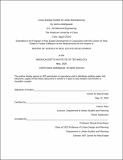Cross-subsidy models for urban manufacturing
Author(s)
Abdelgawad, Salma.
Download1196336893-MIT.pdf (4.086Mb)
Other Contributors
Massachusetts Institute of Technology. Center for Real Estate. Program in Real Estate Development.
Advisor
Kairos Shen.
Terms of use
Metadata
Show full item recordAbstract
Much has been written concerning the positive socio-economic values of urban manufacturing and the need for cities to advocate for the protection of existing middle-income wage jobs in the industrial sector. However, there lie governing factors as to why a use, that has always been essential to communities, has become very hard to grow or even sustain in the present time. Urban growth models were usually developed around the idea that industrial uses are a negative externality. Unlike numerous cities that witnessed complete deindustrialization after World War II, New York City has over the years transformed the identity of its Manufacturing districts. The revival of urban manufacturing in the heart of NYC, where the highest and best use is not in favor of industrial use, has pushed for re-visiting the outdated industrial zoning framework for the first time since the 1961 zoning resolution. The North Brooklyn Industrial Business Zone, a protected manufacturing district spanning across 1,066 acres and the third-largest industrial hub in the city by employment, is set out to become the blueprint for a proposed rezoning framework by NYC's Department of City Planning. The rezoning was initiated as part of the industrial action plan launched in 2015 and aims to create new models for innovative and diverse neighborhoods through mixed-use commercial and industrial uses. In 2018, The Department of City Planning released a draft rezoning framework outlining an additional density to support commercial investment in a growing of a mixed-use market. However, the plan does not define a clear strategy that aims to maintain net-zero losses in industrial jobs. In effect, a simple up-zoning applied to industrial land will not hold back competing uses from outbidding industrial tenants and creating further industrial displacement. By shedding light on New York City's industrial land use policies and the mechanisms that helped maintain and grow its manufacturing ecosystem thus far, this thesis will demonstrate the feasibility and challenges facing industrial space development within the newly proposed North Brooklyn Re-Zoning Framework and under current market conditions. As part of the feasibility study, several deal structures will be explored from private development, public-private partnership, and industrial community land trusts which improve both the feasibility as well as the retention of businesses.
Description
Thesis: S.M. in Real Estate Development, Massachusetts Institute of Technology, Program in Real Estate Development in conjunction with the Center for Real Estate, 2020 Cataloged from the official PDF of thesis. Includes bibliographical references (pages 71-74).
Date issued
2020Department
Massachusetts Institute of Technology. Center for Real EstatePublisher
Massachusetts Institute of Technology
Keywords
Center for Real Estate. Program in Real Estate Development.